Analyzing the Role of Management Accounting in Organizational Strategy
VerifiedAdded on 2020/06/03
|22
|5573
|26
AI Summary
Management accounting serves as a pivotal tool for businesses aiming to enhance their performance through informed strategic decisions and efficient resource allocation. This essay explores the significance of management accounting practices such as activity-based and zero-based budgeting in driving business success. By analyzing these techniques, the paper highlights how they contribute to cost control, improved financial decision-making, and overall organizational effectiveness. The discussion is supported by insights from various academic sources, providing a comprehensive understanding of management accounting's role in fostering sustainable business growth.

MANAGEMENT
ACCOUNTING
ACCOUNTING
Paraphrase This Document
Need a fresh take? Get an instant paraphrase of this document with our AI Paraphraser
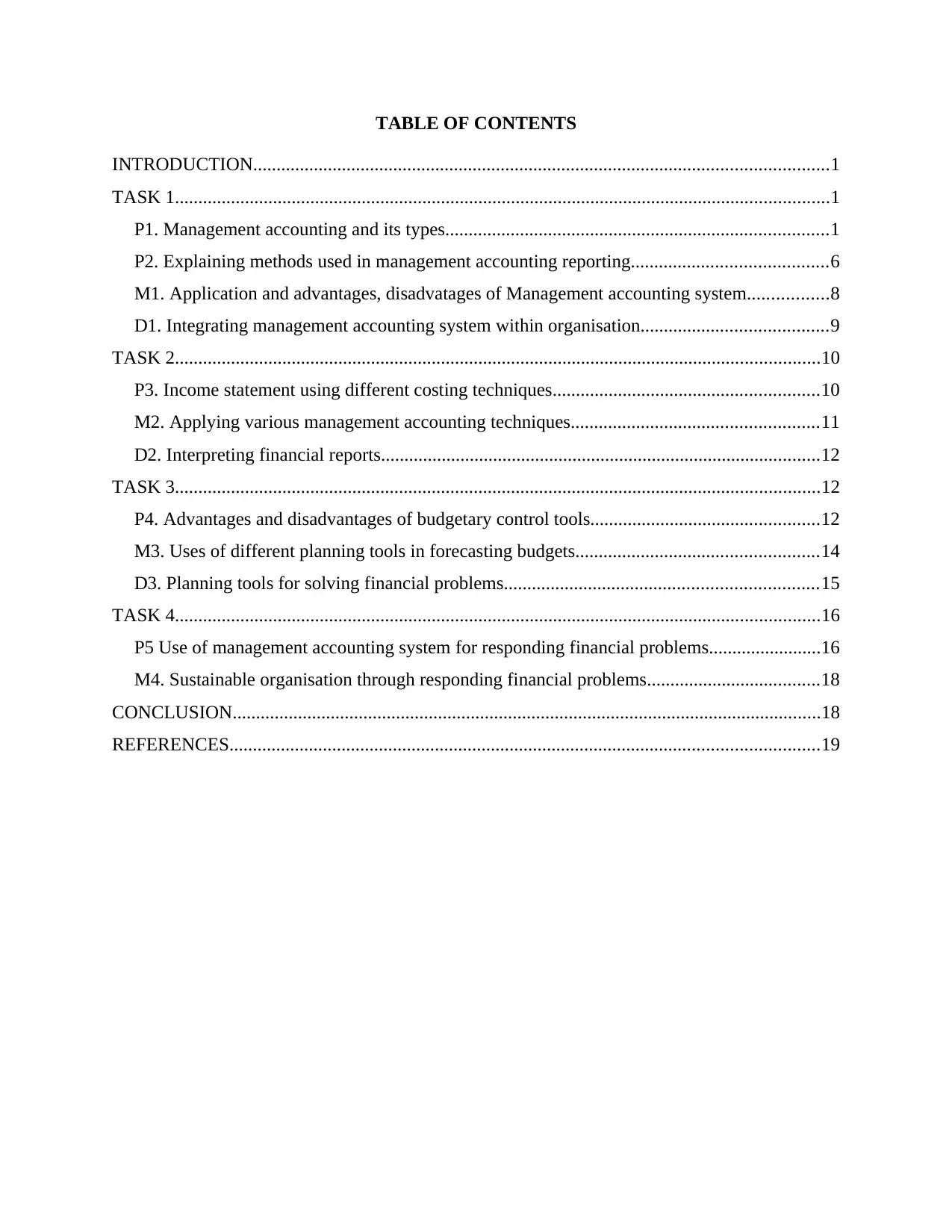
TABLE OF CONTENTS
INTRODUCTION...........................................................................................................................1
TASK 1............................................................................................................................................1
P1. Management accounting and its types..................................................................................1
P2. Explaining methods used in management accounting reporting..........................................6
M1. Application and advantages, disadvatages of Management accounting system.................8
D1. Integrating management accounting system within organisation........................................9
TASK 2..........................................................................................................................................10
P3. Income statement using different costing techniques.........................................................10
M2. Applying various management accounting techniques.....................................................11
D2. Interpreting financial reports..............................................................................................12
TASK 3..........................................................................................................................................12
P4. Advantages and disadvantages of budgetary control tools.................................................12
M3. Uses of different planning tools in forecasting budgets....................................................14
D3. Planning tools for solving financial problems...................................................................15
TASK 4..........................................................................................................................................16
P5 Use of management accounting system for responding financial problems........................16
M4. Sustainable organisation through responding financial problems.....................................18
CONCLUSION..............................................................................................................................18
REFERENCES..............................................................................................................................19
INTRODUCTION...........................................................................................................................1
TASK 1............................................................................................................................................1
P1. Management accounting and its types..................................................................................1
P2. Explaining methods used in management accounting reporting..........................................6
M1. Application and advantages, disadvatages of Management accounting system.................8
D1. Integrating management accounting system within organisation........................................9
TASK 2..........................................................................................................................................10
P3. Income statement using different costing techniques.........................................................10
M2. Applying various management accounting techniques.....................................................11
D2. Interpreting financial reports..............................................................................................12
TASK 3..........................................................................................................................................12
P4. Advantages and disadvantages of budgetary control tools.................................................12
M3. Uses of different planning tools in forecasting budgets....................................................14
D3. Planning tools for solving financial problems...................................................................15
TASK 4..........................................................................................................................................16
P5 Use of management accounting system for responding financial problems........................16
M4. Sustainable organisation through responding financial problems.....................................18
CONCLUSION..............................................................................................................................18
REFERENCES..............................................................................................................................19

INTRODUCTION
Management accounting is an essential part of accounting process in any organisation or
business concern. It is also known as managerial accounting. It is a tool for managers to analyse,
assess and evaluate various aspects of managerial accounting within an organisation. Various
techniques and methods used management accounting system facilitates financial information for
financial reporting and also helps in assessing performance of organisation as a whole and its
individual functions. In the present report different types of management accounting systems and
reports are explained along with their uses in the context of Unicorn Grocery store. It is a small
business of retail store based in UK with less than 50 employees. Main purpose of this report is
to explain how different methods, systems and techniques provides aid to managers and small
business owners in achieving their target objectives and goals along with helping them in making
future economic decisions. In order to fulfil purpose of this report, various topics and discussions
comes under its scope such as advantages of management accounting systems and how the
system can be integrated within an organisation. Further, financial statement has been prepared
for cited firm using two different techniques along with explaining difference between both.
Different planning tools that helps managers in forecasting future events that ultimately
facilitates sustainable growth of business are also explained bvelow.
TASK 1
P1. Management accounting and its types
Following are some types of management accounting system that can be used by Unicorn
Store for improving efficiency of its business operations.
Management accounting is an essential part of accounting process in any organisation or
business concern. It is also known as managerial accounting. It is a tool for managers to analyse,
assess and evaluate various aspects of managerial accounting within an organisation. Various
techniques and methods used management accounting system facilitates financial information for
financial reporting and also helps in assessing performance of organisation as a whole and its
individual functions. In the present report different types of management accounting systems and
reports are explained along with their uses in the context of Unicorn Grocery store. It is a small
business of retail store based in UK with less than 50 employees. Main purpose of this report is
to explain how different methods, systems and techniques provides aid to managers and small
business owners in achieving their target objectives and goals along with helping them in making
future economic decisions. In order to fulfil purpose of this report, various topics and discussions
comes under its scope such as advantages of management accounting systems and how the
system can be integrated within an organisation. Further, financial statement has been prepared
for cited firm using two different techniques along with explaining difference between both.
Different planning tools that helps managers in forecasting future events that ultimately
facilitates sustainable growth of business are also explained bvelow.
TASK 1
P1. Management accounting and its types
Following are some types of management accounting system that can be used by Unicorn
Store for improving efficiency of its business operations.
⊘ This is a preview!⊘
Do you want full access?
Subscribe today to unlock all pages.

Trusted by 1+ million students worldwide

Illustration 1: Management accounting system
Source: (AbRahman and et.al., 2016)
Inventory management system:
This project is mainly designed for various companies to manage their:
Employees
Customers
Vendors
Inventory
Sales
Accounting
Various reports
IMS helps a business be successful because it provides the direct control over the organisation
and keep tracks all of things.
Source: (AbRahman and et.al., 2016)
Inventory management system:
This project is mainly designed for various companies to manage their:
Employees
Customers
Vendors
Inventory
Sales
Accounting
Various reports
IMS helps a business be successful because it provides the direct control over the organisation
and keep tracks all of things.
Paraphrase This Document
Need a fresh take? Get an instant paraphrase of this document with our AI Paraphraser
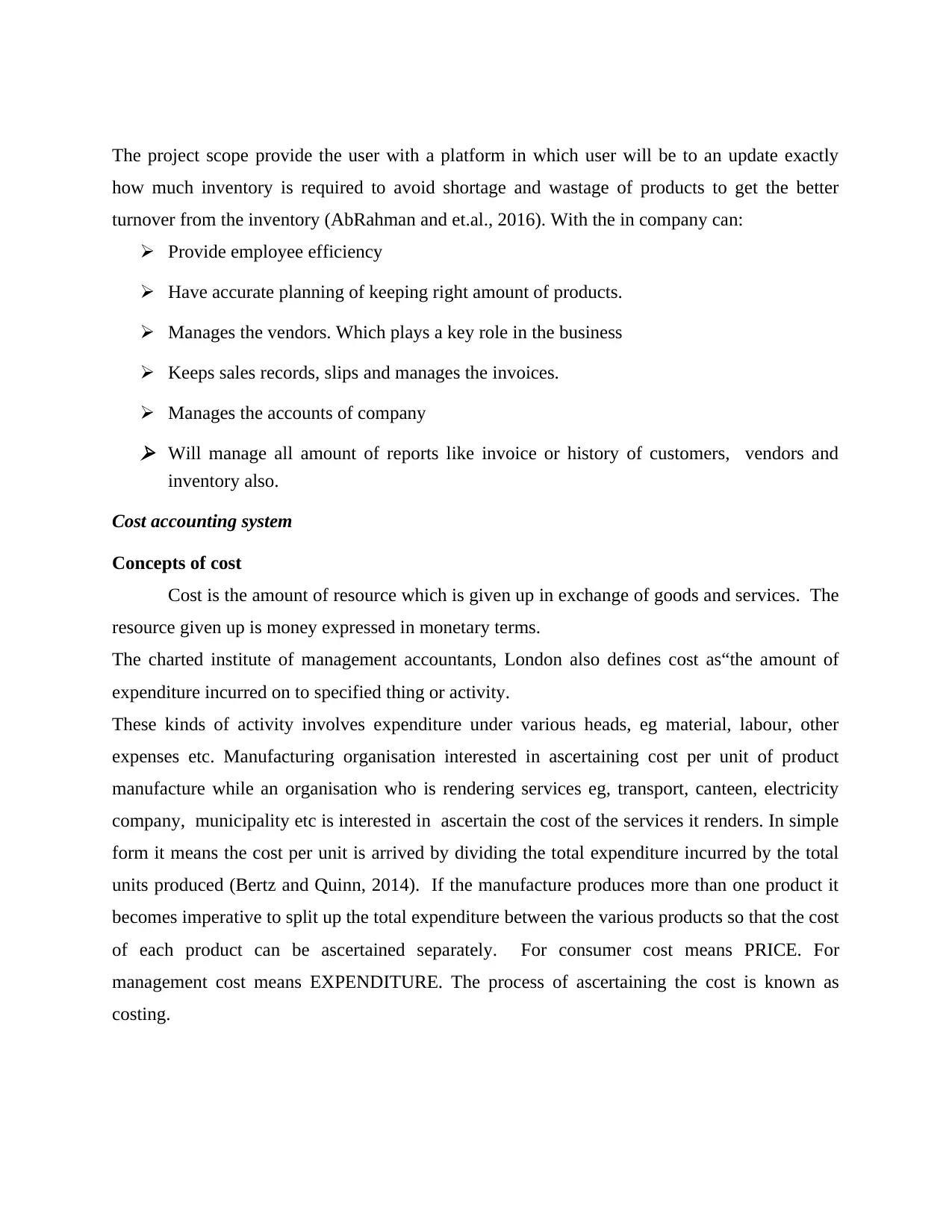
The project scope provide the user with a platform in which user will be to an update exactly
how much inventory is required to avoid shortage and wastage of products to get the better
turnover from the inventory (AbRahman and et.al., 2016). With the in company can:
Provide employee efficiency
Have accurate planning of keeping right amount of products.
Manages the vendors. Which plays a key role in the business
Keeps sales records, slips and manages the invoices.
Manages the accounts of company Will manage all amount of reports like invoice or history of customers, vendors and
inventory also.
Cost accounting system
Concepts of cost
Cost is the amount of resource which is given up in exchange of goods and services. The
resource given up is money expressed in monetary terms.
The charted institute of management accountants, London also defines cost as“the amount of
expenditure incurred on to specified thing or activity.
These kinds of activity involves expenditure under various heads, eg material, labour, other
expenses etc. Manufacturing organisation interested in ascertaining cost per unit of product
manufacture while an organisation who is rendering services eg, transport, canteen, electricity
company, municipality etc is interested in ascertain the cost of the services it renders. In simple
form it means the cost per unit is arrived by dividing the total expenditure incurred by the total
units produced (Bertz and Quinn, 2014). If the manufacture produces more than one product it
becomes imperative to split up the total expenditure between the various products so that the cost
of each product can be ascertained separately. For consumer cost means PRICE. For
management cost means EXPENDITURE. The process of ascertaining the cost is known as
costing.
how much inventory is required to avoid shortage and wastage of products to get the better
turnover from the inventory (AbRahman and et.al., 2016). With the in company can:
Provide employee efficiency
Have accurate planning of keeping right amount of products.
Manages the vendors. Which plays a key role in the business
Keeps sales records, slips and manages the invoices.
Manages the accounts of company Will manage all amount of reports like invoice or history of customers, vendors and
inventory also.
Cost accounting system
Concepts of cost
Cost is the amount of resource which is given up in exchange of goods and services. The
resource given up is money expressed in monetary terms.
The charted institute of management accountants, London also defines cost as“the amount of
expenditure incurred on to specified thing or activity.
These kinds of activity involves expenditure under various heads, eg material, labour, other
expenses etc. Manufacturing organisation interested in ascertaining cost per unit of product
manufacture while an organisation who is rendering services eg, transport, canteen, electricity
company, municipality etc is interested in ascertain the cost of the services it renders. In simple
form it means the cost per unit is arrived by dividing the total expenditure incurred by the total
units produced (Bertz and Quinn, 2014). If the manufacture produces more than one product it
becomes imperative to split up the total expenditure between the various products so that the cost
of each product can be ascertained separately. For consumer cost means PRICE. For
management cost means EXPENDITURE. The process of ascertaining the cost is known as
costing.
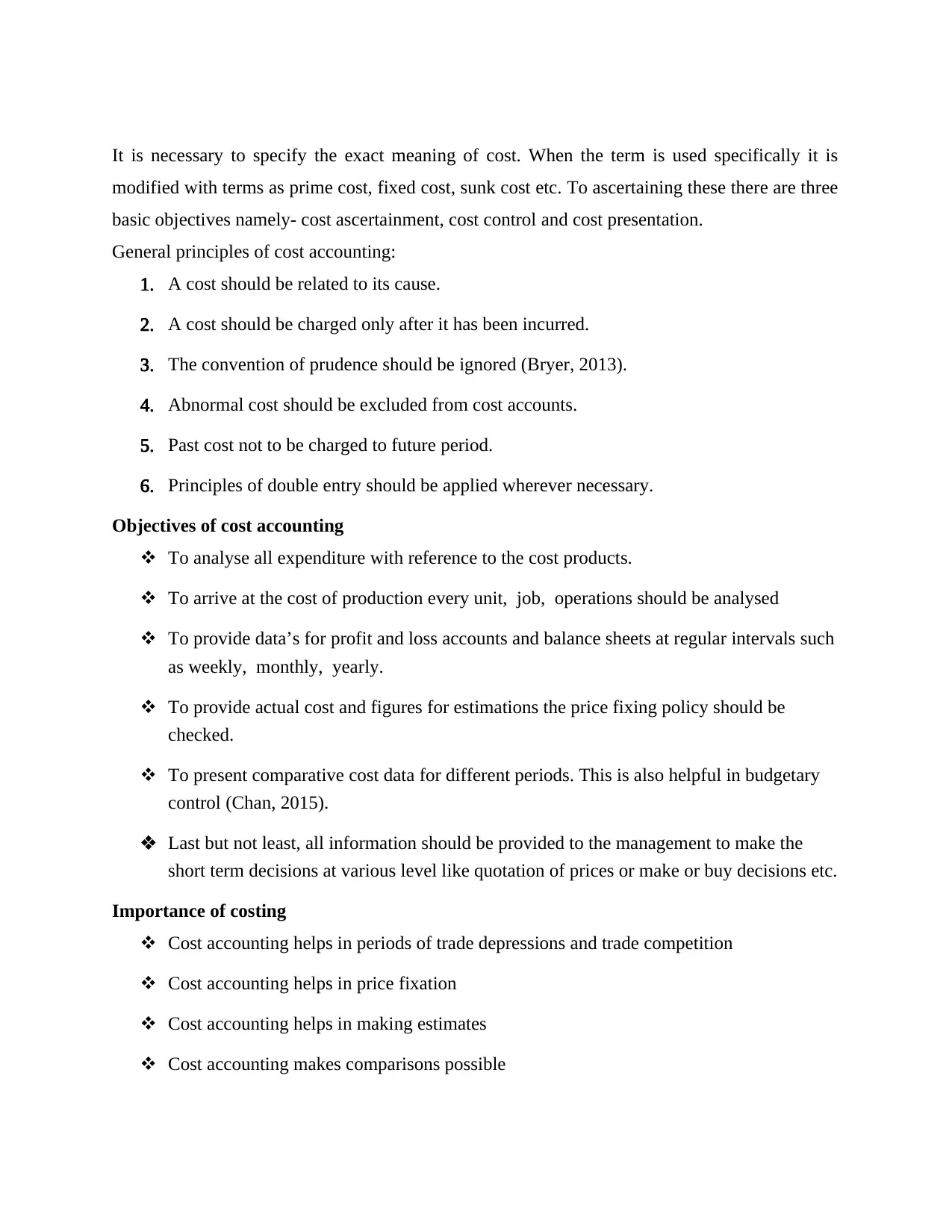
It is necessary to specify the exact meaning of cost. When the term is used specifically it is
modified with terms as prime cost, fixed cost, sunk cost etc. To ascertaining these there are three
basic objectives namely- cost ascertainment, cost control and cost presentation.
General principles of cost accounting:
1. A cost should be related to its cause.
2. A cost should be charged only after it has been incurred.
3. The convention of prudence should be ignored (Bryer, 2013).
4. Abnormal cost should be excluded from cost accounts.
5. Past cost not to be charged to future period.
6. Principles of double entry should be applied wherever necessary.
Objectives of cost accounting
To analyse all expenditure with reference to the cost products.
To arrive at the cost of production every unit, job, operations should be analysed
To provide data’s for profit and loss accounts and balance sheets at regular intervals such
as weekly, monthly, yearly.
To provide actual cost and figures for estimations the price fixing policy should be
checked.
To present comparative cost data for different periods. This is also helpful in budgetary
control (Chan, 2015).
Last but not least, all information should be provided to the management to make the
short term decisions at various level like quotation of prices or make or buy decisions etc.
Importance of costing
Cost accounting helps in periods of trade depressions and trade competition
Cost accounting helps in price fixation
Cost accounting helps in making estimates
Cost accounting makes comparisons possible
modified with terms as prime cost, fixed cost, sunk cost etc. To ascertaining these there are three
basic objectives namely- cost ascertainment, cost control and cost presentation.
General principles of cost accounting:
1. A cost should be related to its cause.
2. A cost should be charged only after it has been incurred.
3. The convention of prudence should be ignored (Bryer, 2013).
4. Abnormal cost should be excluded from cost accounts.
5. Past cost not to be charged to future period.
6. Principles of double entry should be applied wherever necessary.
Objectives of cost accounting
To analyse all expenditure with reference to the cost products.
To arrive at the cost of production every unit, job, operations should be analysed
To provide data’s for profit and loss accounts and balance sheets at regular intervals such
as weekly, monthly, yearly.
To provide actual cost and figures for estimations the price fixing policy should be
checked.
To present comparative cost data for different periods. This is also helpful in budgetary
control (Chan, 2015).
Last but not least, all information should be provided to the management to make the
short term decisions at various level like quotation of prices or make or buy decisions etc.
Importance of costing
Cost accounting helps in periods of trade depressions and trade competition
Cost accounting helps in price fixation
Cost accounting helps in making estimates
Cost accounting makes comparisons possible
⊘ This is a preview!⊘
Do you want full access?
Subscribe today to unlock all pages.

Trusted by 1+ million students worldwide
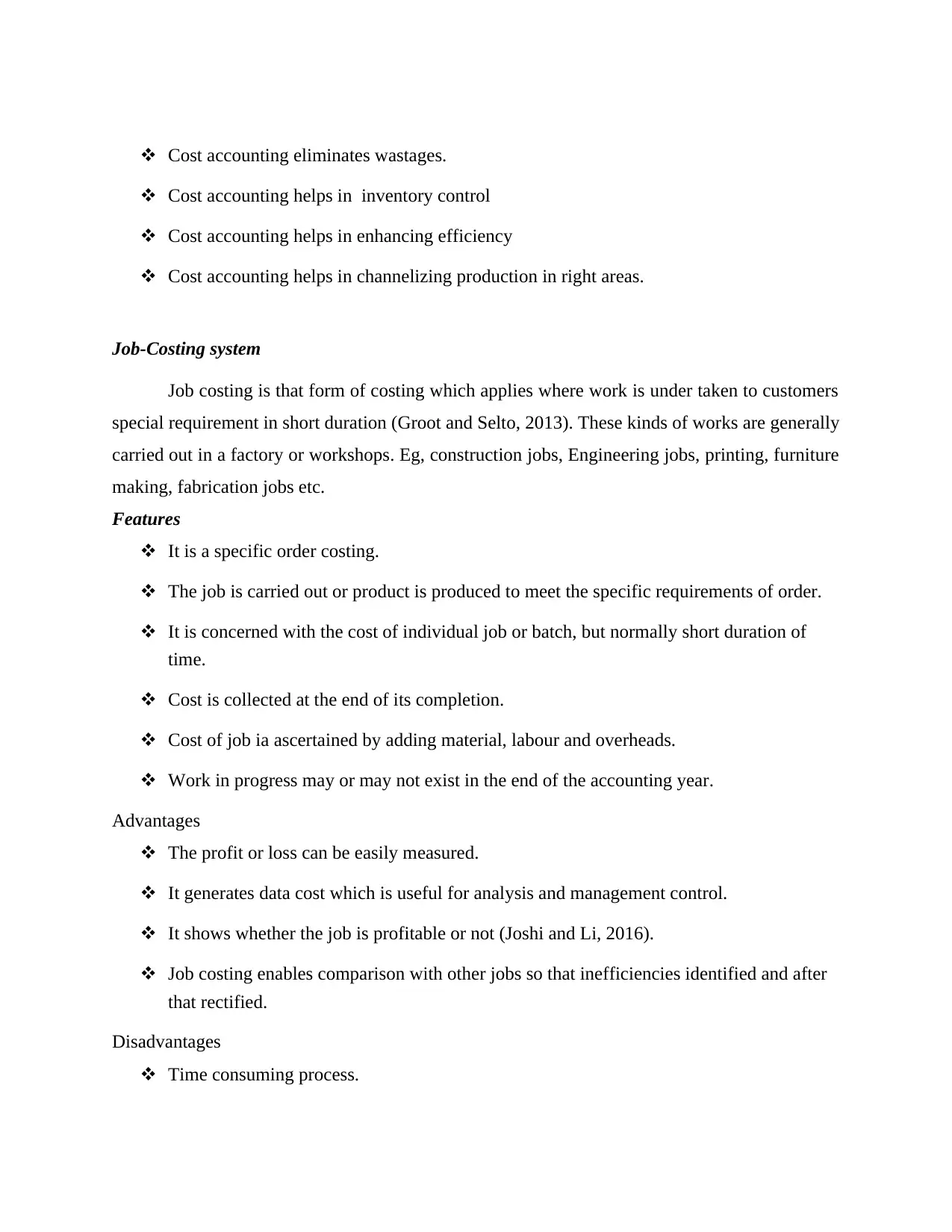
Cost accounting eliminates wastages.
Cost accounting helps in inventory control
Cost accounting helps in enhancing efficiency
Cost accounting helps in channelizing production in right areas.
Job-Costing system
Job costing is that form of costing which applies where work is under taken to customers
special requirement in short duration (Groot and Selto, 2013). These kinds of works are generally
carried out in a factory or workshops. Eg, construction jobs, Engineering jobs, printing, furniture
making, fabrication jobs etc.
Features
It is a specific order costing.
The job is carried out or product is produced to meet the specific requirements of order.
It is concerned with the cost of individual job or batch, but normally short duration of
time.
Cost is collected at the end of its completion.
Cost of job ia ascertained by adding material, labour and overheads.
Work in progress may or may not exist in the end of the accounting year.
Advantages
The profit or loss can be easily measured.
It generates data cost which is useful for analysis and management control.
It shows whether the job is profitable or not (Joshi and Li, 2016).
Job costing enables comparison with other jobs so that inefficiencies identified and after
that rectified.
Disadvantages
Time consuming process.
Cost accounting helps in inventory control
Cost accounting helps in enhancing efficiency
Cost accounting helps in channelizing production in right areas.
Job-Costing system
Job costing is that form of costing which applies where work is under taken to customers
special requirement in short duration (Groot and Selto, 2013). These kinds of works are generally
carried out in a factory or workshops. Eg, construction jobs, Engineering jobs, printing, furniture
making, fabrication jobs etc.
Features
It is a specific order costing.
The job is carried out or product is produced to meet the specific requirements of order.
It is concerned with the cost of individual job or batch, but normally short duration of
time.
Cost is collected at the end of its completion.
Cost of job ia ascertained by adding material, labour and overheads.
Work in progress may or may not exist in the end of the accounting year.
Advantages
The profit or loss can be easily measured.
It generates data cost which is useful for analysis and management control.
It shows whether the job is profitable or not (Joshi and Li, 2016).
Job costing enables comparison with other jobs so that inefficiencies identified and after
that rectified.
Disadvantages
Time consuming process.
Paraphrase This Document
Need a fresh take? Get an instant paraphrase of this document with our AI Paraphraser

Expensive
P2. Explaining methods used in management accounting reporting
Illustration 2: Management accounting reports
Source: (Khodzytska and Ivchenko, 2014)
Management accounting reports are also known as cost accounting reports. Which are
basically designed to offer internal information to organisation or companies through financial
accounting? The main purpose of management accounting reports is to help is to planning,
monitoring, determining decision. Management accountants depends upon standard financial
reports such as
Balance sheet
Income reports
Cash reports
Other management accounting reports
P2. Explaining methods used in management accounting reporting
Illustration 2: Management accounting reports
Source: (Khodzytska and Ivchenko, 2014)
Management accounting reports are also known as cost accounting reports. Which are
basically designed to offer internal information to organisation or companies through financial
accounting? The main purpose of management accounting reports is to help is to planning,
monitoring, determining decision. Management accountants depends upon standard financial
reports such as
Balance sheet
Income reports
Cash reports
Other management accounting reports

Management accountants use information not only financial but accounting as well as
management skills (Khodzytska and Ivchenko, 2014). Few of the above mentioned reports are
explained as below that can be used by Unicorn Store:
Cost reports
Cost reports help management accountant to calculate cost of items that are produced
through to unprocessed data. Such data includes:
Cost of products
Overheads
Labour cost etc
Cost reports are also called management accounting reports which are used for the purpose of
planning and profit margins.
Budget reports
With many types of management accounting reports, the budget reports are also an
important report. The main purpose of budget report is to create budget from previous years data
to make future predictions (Klemstine and Maher, 2014). Supply of revenues and expenses must
be in the budget reports and company must work within the amount that has been calculated in
the budget.
Budget reports help small company owners to analyse their performance. If there is big
company owners managers should analyse departments control cost. If small business owners
were over budget in the previous year and can’t trim their cost, the budget for future years needs
to be increased to a more accurate level. Owners and managers use budget reports to give
incentives to their employees, as well as for giving bonus also for meeting their specific goals.
Performance report
Another type of management accounting report is performance report. These kinds of
reports are used by management accountants to analyse expenditures and revenues to amounts
that have been allocated. These inequalities are computed to help in deciding new budget. These
management skills (Khodzytska and Ivchenko, 2014). Few of the above mentioned reports are
explained as below that can be used by Unicorn Store:
Cost reports
Cost reports help management accountant to calculate cost of items that are produced
through to unprocessed data. Such data includes:
Cost of products
Overheads
Labour cost etc
Cost reports are also called management accounting reports which are used for the purpose of
planning and profit margins.
Budget reports
With many types of management accounting reports, the budget reports are also an
important report. The main purpose of budget report is to create budget from previous years data
to make future predictions (Klemstine and Maher, 2014). Supply of revenues and expenses must
be in the budget reports and company must work within the amount that has been calculated in
the budget.
Budget reports help small company owners to analyse their performance. If there is big
company owners managers should analyse departments control cost. If small business owners
were over budget in the previous year and can’t trim their cost, the budget for future years needs
to be increased to a more accurate level. Owners and managers use budget reports to give
incentives to their employees, as well as for giving bonus also for meeting their specific goals.
Performance report
Another type of management accounting report is performance report. These kinds of
reports are used by management accountants to analyse expenditures and revenues to amounts
that have been allocated. These inequalities are computed to help in deciding new budget. These
⊘ This is a preview!⊘
Do you want full access?
Subscribe today to unlock all pages.

Trusted by 1+ million students worldwide
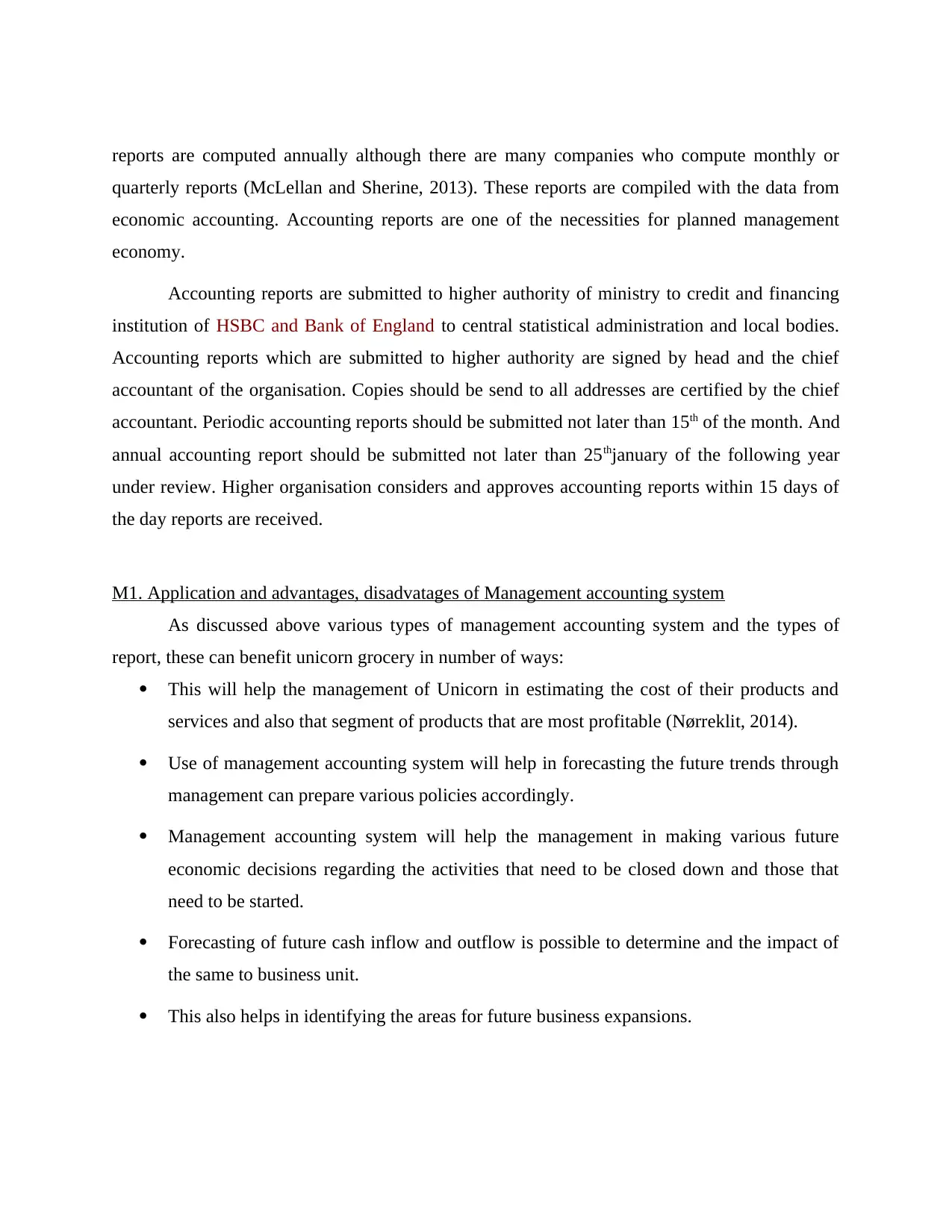
reports are computed annually although there are many companies who compute monthly or
quarterly reports (McLellan and Sherine, 2013). These reports are compiled with the data from
economic accounting. Accounting reports are one of the necessities for planned management
economy.
Accounting reports are submitted to higher authority of ministry to credit and financing
institution of HSBC and Bank of England to central statistical administration and local bodies.
Accounting reports which are submitted to higher authority are signed by head and the chief
accountant of the organisation. Copies should be send to all addresses are certified by the chief
accountant. Periodic accounting reports should be submitted not later than 15th of the month. And
annual accounting report should be submitted not later than 25thjanuary of the following year
under review. Higher organisation considers and approves accounting reports within 15 days of
the day reports are received.
M1. Application and advantages, disadvatages of Management accounting system
As discussed above various types of management accounting system and the types of
report, these can benefit unicorn grocery in number of ways:
This will help the management of Unicorn in estimating the cost of their products and
services and also that segment of products that are most profitable (Nørreklit, 2014).
Use of management accounting system will help in forecasting the future trends through
management can prepare various policies accordingly.
Management accounting system will help the management in making various future
economic decisions regarding the activities that need to be closed down and those that
need to be started.
Forecasting of future cash inflow and outflow is possible to determine and the impact of
the same to business unit.
This also helps in identifying the areas for future business expansions.
quarterly reports (McLellan and Sherine, 2013). These reports are compiled with the data from
economic accounting. Accounting reports are one of the necessities for planned management
economy.
Accounting reports are submitted to higher authority of ministry to credit and financing
institution of HSBC and Bank of England to central statistical administration and local bodies.
Accounting reports which are submitted to higher authority are signed by head and the chief
accountant of the organisation. Copies should be send to all addresses are certified by the chief
accountant. Periodic accounting reports should be submitted not later than 15th of the month. And
annual accounting report should be submitted not later than 25thjanuary of the following year
under review. Higher organisation considers and approves accounting reports within 15 days of
the day reports are received.
M1. Application and advantages, disadvatages of Management accounting system
As discussed above various types of management accounting system and the types of
report, these can benefit unicorn grocery in number of ways:
This will help the management of Unicorn in estimating the cost of their products and
services and also that segment of products that are most profitable (Nørreklit, 2014).
Use of management accounting system will help in forecasting the future trends through
management can prepare various policies accordingly.
Management accounting system will help the management in making various future
economic decisions regarding the activities that need to be closed down and those that
need to be started.
Forecasting of future cash inflow and outflow is possible to determine and the impact of
the same to business unit.
This also helps in identifying the areas for future business expansions.
Paraphrase This Document
Need a fresh take? Get an instant paraphrase of this document with our AI Paraphraser

Through this management can also determine the variations in forecasted budgets of cost
and sales and actual amount of expenses and sales volume.
However, these techniques will be helpful for the business in terms of making the
adequate improvement in the operational or financial performance. Therefore, such techniques
will increase the productivity as well as make the adequate increment in efficiency of firm.
D1. Integrating management accounting system within organisation
As the need of management accounting has been discussed in the above report. The need
of its integration within the organisation also increases (Fullerton, Kennedy and Widener, 2013).
Before integrating management accounting management should identify the key areas that
require integration System of management accounting can be integrated in Unicorn grocery by:
Setting the prices of different segments of products and services.
By providing cost centres of goods and services.
Preparation of budgets for various activities in different departments.
Preparing centralised budget for the company as a whole.
Developing budgets for staff development.
By conducting personal meetings and interview with key personnel of the organisation.
Identifying best practices that are required by the organisation.
Explaining purpose of integrating management system to the employees.
In terms with making the improvements in the operational activities of the business there
can be need to analyse the requirements of funds, efforts in any business tasks. The managers of
Unicorn must concentrate over utilisation resources in consideration with the market needs and
wants.
and sales and actual amount of expenses and sales volume.
However, these techniques will be helpful for the business in terms of making the
adequate improvement in the operational or financial performance. Therefore, such techniques
will increase the productivity as well as make the adequate increment in efficiency of firm.
D1. Integrating management accounting system within organisation
As the need of management accounting has been discussed in the above report. The need
of its integration within the organisation also increases (Fullerton, Kennedy and Widener, 2013).
Before integrating management accounting management should identify the key areas that
require integration System of management accounting can be integrated in Unicorn grocery by:
Setting the prices of different segments of products and services.
By providing cost centres of goods and services.
Preparation of budgets for various activities in different departments.
Preparing centralised budget for the company as a whole.
Developing budgets for staff development.
By conducting personal meetings and interview with key personnel of the organisation.
Identifying best practices that are required by the organisation.
Explaining purpose of integrating management system to the employees.
In terms with making the improvements in the operational activities of the business there
can be need to analyse the requirements of funds, efforts in any business tasks. The managers of
Unicorn must concentrate over utilisation resources in consideration with the market needs and
wants.
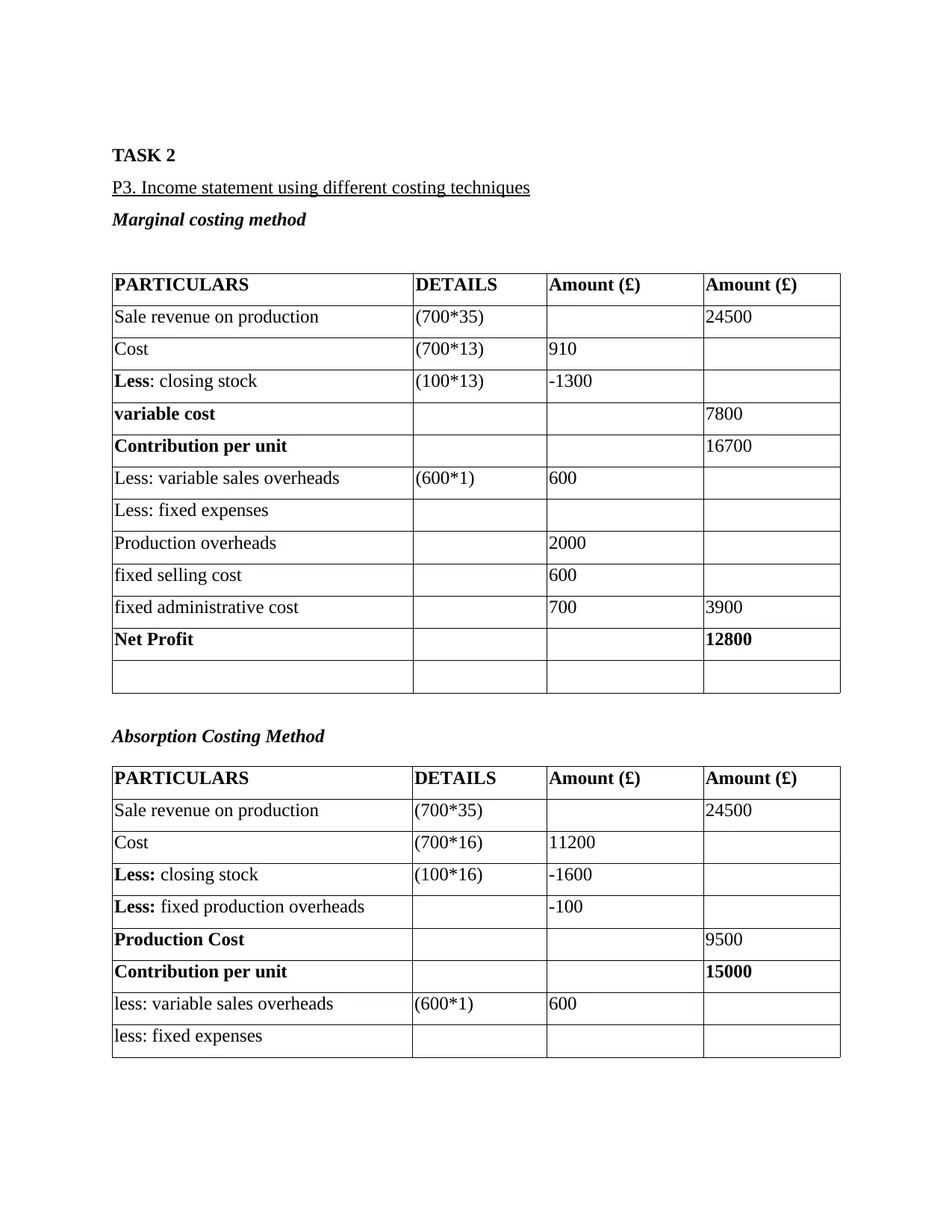
TASK 2
P3. Income statement using different costing techniques
Marginal costing method
PARTICULARS DETAILS Amount (£) Amount (£)
Sale revenue on production (700*35) 24500
Cost (700*13) 910
Less: closing stock (100*13) -1300
variable cost 7800
Contribution per unit 16700
Less: variable sales overheads (600*1) 600
Less: fixed expenses
Production overheads 2000
fixed selling cost 600
fixed administrative cost 700 3900
Net Profit 12800
Absorption Costing Method
PARTICULARS DETAILS Amount (£) Amount (£)
Sale revenue on production (700*35) 24500
Cost (700*16) 11200
Less: closing stock (100*16) -1600
Less: fixed production overheads -100
Production Cost 9500
Contribution per unit 15000
less: variable sales overheads (600*1) 600
less: fixed expenses
P3. Income statement using different costing techniques
Marginal costing method
PARTICULARS DETAILS Amount (£) Amount (£)
Sale revenue on production (700*35) 24500
Cost (700*13) 910
Less: closing stock (100*13) -1300
variable cost 7800
Contribution per unit 16700
Less: variable sales overheads (600*1) 600
Less: fixed expenses
Production overheads 2000
fixed selling cost 600
fixed administrative cost 700 3900
Net Profit 12800
Absorption Costing Method
PARTICULARS DETAILS Amount (£) Amount (£)
Sale revenue on production (700*35) 24500
Cost (700*16) 11200
Less: closing stock (100*16) -1600
Less: fixed production overheads -100
Production Cost 9500
Contribution per unit 15000
less: variable sales overheads (600*1) 600
less: fixed expenses
⊘ This is a preview!⊘
Do you want full access?
Subscribe today to unlock all pages.

Trusted by 1+ million students worldwide
1 out of 22
Related Documents
Your All-in-One AI-Powered Toolkit for Academic Success.
+13062052269
info@desklib.com
Available 24*7 on WhatsApp / Email
![[object Object]](/_next/static/media/star-bottom.7253800d.svg)
Unlock your academic potential
Copyright © 2020–2025 A2Z Services. All Rights Reserved. Developed and managed by ZUCOL.





